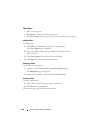
108 Protecting Data on PowerVault NX3500
Replication
Replication is used in various scenarios to achieve different levels of data
protection. Some of these include:
• Fast backup and restore: Maintain full copies of data for protection against
data loss, corruption, or user mistakes.
• Disaster recovery: Mirror data to remote locations for failover.
• Remote data access: Applications can access mirrored data in read-only or
read-write mode.
• Online data migration: Minimize downtime associated with data migration.
NAS Replication
Replication leverages the snapshot technology in the PowerVault NX3500 file
system. After the first replication, only deltas are replicated. This allows for
faster replication and efficient use of the CPU cycles. It also saves on storage
space while keeping data consistent.
Replication is volume based and can be used to replicate volumes on the
same PowerVault NX3500 system (see Figure 7-1) or a volume on another
PowerVault NX3500 system (see Figure 7-2). When replicating a volume to
another PowerVault NX3500 system, the other system must be setup as a
replication partner.
Once a partner relationship is established, replication is bi-directional. One
system could hold target volumes for the other system as well as source
volumes to replicate to that other system. Replication data flows through a
secure ssh tunnel from system to system over the client network.
A replication policy can be setup to run on various schedules as well as on
demand. All system configurations (user quotas, snapshot policy, and so on)
are stored on each volume. When a volume is replicated, the target volume
holds identical information. When removing a replication policy, an option is
provided for transferring the volume configuration.
Antivirus
Antivirus Hosts
Allows you to add and delete anti-virus hosts and
corresponding ICAP port.
Field Description


















